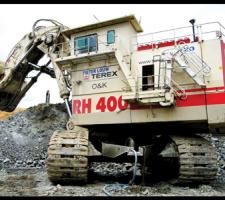
Hydraulic excavators are the subject of a new book which looks in detail at the machines and how they are used
Hydraulic excavators are now the most widely used of all off-highway machines but that the hydraulic excavator has become, effectively, ubiquitous is of note.
This was how Aggregates Business Europe described the hydraulic excavator in a 2008 Quarry Classics.
It went on to say: “The current generation of hydraulic excavators are descended from machines developed 60 or so years ago, which is a considerably shorter time than for other pieces of equipment, such as the bulldozer or grader.”
Now, Rob Sinclair, who says he has been interested in hydraulic excavators since the age of four (nearly 37 years ago) has published a new book on the subject, Hydraulic Excavators: Quarrying & Mining Applications.
“The primary reason for writing this book is my passion for the subject matter. However, in addition to those people already involved and working with hydraulic excavators in quarrying and mining applications, an important objective was to produce a book for young people who, like myself, have a keen interest in these industries and are considering a career in them,” says Sinclair.
He started writing the book in August, 2010, and 115,000 words, 388 pages and over 400 photographs later the weighty tome was published late last year in hardback format and is available at Amazon (ISBN:978-1-906148-35-5, £45 sterling).
“I took the photographs over many years (the oldest of which dates to 1986) with cameras of varying quality. Although the more recent digital images are clearly to a higher quality, I believe that the scanned film shots make a very valuable contribution,” says Sinclair in his foreword.
Hydraulic Excavators: Quarrying and Mining Applications is a book that covers hydraulic excavators in both product technical detail and their usage in quarrying and mining applications, typically larger models being featured due to their more frequent role as prime movers.
Sinclair says that while he has an interest in all crawler hydraulic excavators from the 13tonne class and above, he has covered excavators from approximately 40tonnes and over because they more usually act as prime movers in quarries and mines.
“The primary focus is the hydraulic excavator, however, and in order to determine why a certain size and configuration should be selected, an understanding of the application is required.
“In addition to describing reasons for their selection and how the application is undertaken, the book details how performance can be calculated and provides examples of actual production volumes achieved when extracting various types of materials by the use of explosives and direct methods,” says Sinclair.
In total more than 75 (not including series change) excavator models are featured and the photographs are used to show the machines at work in Europe, South Africa and North America.
“The increasing need for a considerable array of minerals and the five-stages of quarrying and mining is provided in order to understand why the hydraulic excavator is such common place in these industries.”
Hydraulic Excavators: Quarrying & Mining Applications comprises three chapters, the first looking at the hydraulic excavator’s main systems and components.
Chapter 2 focuses on quarrying and mining and includes minerals derived from these activities along with the open pit quarrying and mining process; methods of extraction when using hydraulic excavators; buckets and ground engaging tools, and performance and excavator selection.
The final chapter features and discusses in considerable detail approximately 75 excavator models.
“A lot of specification/technical details are prodvided, perhaps too much for some, because I also wanted to produce
a reference book which details many excavators long since out of production.”















